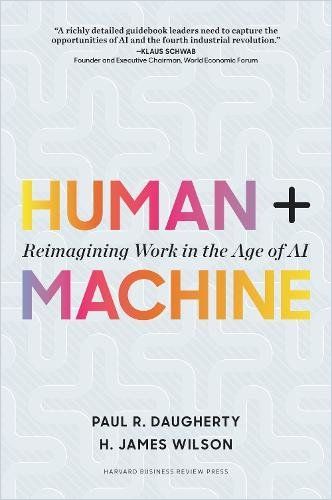An insightful, knowledgeable, fanciful discussion of the future synergy among people, AI and robots.

Don’t Fear the Robots
Senior executives at Accenture’s IT business, Paul R. Daugherty and H. James Wilson argue persuasively that success in the era of AI isn’t about full automation and throwing millions of people out of work. The authors predict a way forward that combines AI’s strengths – processing, stamina, pattern recognition and consistency – with human soft skills – creativity, judgment and emotional intelligence. This synergy, they maintain, will improve AI while freeing employees from tedium and giving them “superpowers.” The authors describe future jobs that seem unlikely – HR specialists for robots, for example – but they believe AI could fuel a workers’ paradise even in the short term.
Daugherty and Wilson’s main theme is that success in the AI era depends on rethinking how robots, AI and people will collaborate in your company and your industry.
The authors present this onrushing era with wit and verve and an intelligent sci-fi writer’s gee-whiz enthusiasm. Little wonder Fortune CEO Daily named it a Best Business Book of 2018 or that The Wall Street Journal said, “Readers gain a tactile sense of how technology changes business over time…”
A New Era
The authors caution that the AI revolution marks a new era in human history. They believe AI’s transformations will eclipse the first two eras of automation – industrialization and computerization. Humans and AI – including robots equipped with AI – will enable firms to hyper-individualize offerings, giving people what they want and need as they desire it. Daugherty and Wilson – with perhaps an excess of enthusiasm – insist this will transform the world as people making AI smarter and AI making people superhuman fuels fantastic new discoveries and processes.
Exponential Speed
Whether at the office, the factory floor, the home, the lab or in stores, Daugherty and Wilson document how AI keeps improving. The authors explain that AI already functions in companies in the form of chatbots that answer most customer telephone and chat inquiries, and that AI recruiters screen job applicants.
Where finding a mass-market hit was once a company’s primary driver, ultra customization is becoming an increasingly critical – and economically feasible – approach. Paul R. Daugherty and H. James Wilson
The authors describe how AI mannequins in stores will “see” you, sense your mood, and check your buying history and recent social media activity to gather intelligence for a human sales rep. Incongruously, Daugherty and Wilson don’t advise whether this will help you shop or scare you to death.
Robots and People
Daugherty and Wilson believe that – while AI will automate some jobs entirely – AI’s true utility lies in augmenting and complementing human abilities. The authors caution that you cannot simply replace people with machines. That might bring short-term gain, they warn, but poor competitive performance in the long term. The authors repeatedly describe the space in between what robots and humans do as the “missing middle” – territory that bridges AI and human strengths into something more powerful than the sum of its parts.
Daugherty and Wilson promise that AI will increase your intelligence, creativity and enjoyment of work. For example, the authors cite the Mercedes factory where robots equipped with AI augment human creativity and emotional intelligence.
Leaders Matter
When leaders enable human and robot collaboration, say the authors, they will create significant efficiencies and new business models. In Daugherty and Wilson’s primary message to leaders about how they must change, the authors insist that executives must open their minds, assuage their employees’ fears, encourage experimentation, demand ethical use of AI, and understand the bottomless need for constant, voluminous, disparate and fast data from myriad sources.
Companies that are using machines merely to replace humans will eventually stall, whereas those that think of innovative ways for machines to augment humans will become the leaders of their industries. Paul R. Daugherty and H. James Wilson
People already embrace technology – from “glasses to fighter jets” – and other tools that augment their capabilities. Daugherty and Wilson offer AI robots as the latest tools to make business and life better.
Changes Everything
Leaders can apply the authors’ futuristic approach to keep their firms relevant as AI changes services, products, jobs, businesses and industries. Daugherty and Wilson skirt the question of AI’s function and its role over the longer term. They frequently restate their view that AI will liberate employees from monotony to let them focus on higher-order, more meaningful and creative work.
Daugherty and Wilson write as they likely speak, and their work at times feels like transcriptions of presentations. They skate rapidly across the surface of their ideas and don’t waste a word on philosophy, morals or entirely practical futurism. They offer an excellent introduction for executives, entrepreneurs and students seeking a cogent overview of the oncoming integration of AI and human beings.
The leading firms in many industries are now reimagining their processes to be more flexible, faster and adaptable to the behaviors, preferences and needs of their workers at a given moment.
Paul R. Daugherty and H. James Wilson
Their flights of fancy, however, do not embrace the quotidian sufficiently to explain how a truck driver, for example, will find more creative and meaningful work once his truck drives itself. Nor do they delve into why, after exponentially increasingly intelligent AI learns everything people can teach it, AI would still need humans at all.
Illuminating books that address parallel issues with varying levels of whimsy and functional business advice include Peter H. Diamandis’s The Future Is Faster Than You Think, Martin Ford’s The Rise of the Robots, Prediction Machines by Ajay Agrawal and Competing in the Age of AI by Marco Iansiti.










